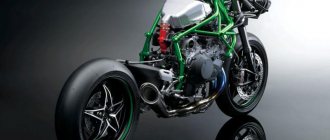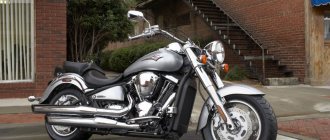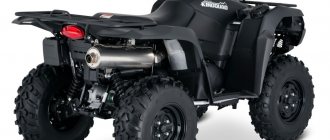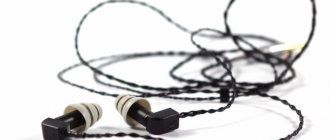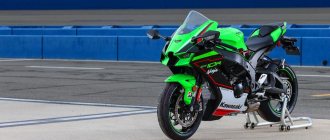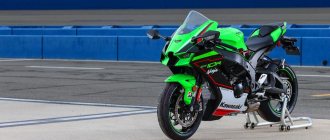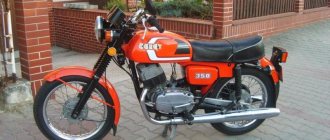The release of the Kawasaki Ninja H2R did not surprise anyone, because several years earlier the Japanese company had already successfully tested its strength in the supersport class, offering motorcyclists the ZX-14R model. The characteristics of the ambitious newcomer were surprising - Kawasaki representatives, without false modesty, stated that they had developed the world's most powerful production hyperbike, also equipped boost system, increasing the already high engine power. And we must admit that this statement was not empty boasting. The new Ninja has set a new quality standard in its class.
Specifications
The most expensive and most powerful mass-produced hyperbike , what should it be? Powerful, fast, dynamic, with predictable handling and effective braking... This goes without saying, but you need to find the optimal balance between all these parameters. The designers succeeded, and they presented the public with the most advanced sports motorcycle in history. The Kawasaki Ninja H2R has technical characteristics that fully justify the high price.
Engine
The 4-cylinder, 4-valve liquid power unit with a volume of 998 cm² is the most powerful in its class. Additionally, it is supercharged with a 2-speed centrifugal supercharger , and in the Kawasaki Ninja H2R racing version it produces a record 310 hp! In the civilian version, the figures are somewhat more modest, from 200 hp. up to 231 hp (for H2 2019+ model years). The sports-touring modification of the H2 SX is distinguished by a retuned engine charged with “only” 150-170 hp. depending on the sales market. Peak torque is achieved between 8,000 (SX) and 12,500 rpm (H2R), and ranges from 128 to 165 Nm . All engine modifications are equipped with double injectors, and they prefer to be powered only by the highest quality gasoline.
Transmission
The Kawasaki Ninja H2R is equipped with a 6-speed transmission , which in 2021 migrated to the naked Z H2, which went on sale. The gearbox works very smoothly, and even allows some liberties - if desired, you can already reach a speed of more than 200 km/h in third gear.
Chassis and brakes
The steel trellis frame offers excellent flexural and torsional strength, and the bike behaves predictably even in long, high-speed corners when subjected to extreme stress. The front wheel has two 330 mm brake discs (320 mm in the SX version) with 4-piston calipers, and the rear wheel has one 250 mm disc with a 2-piston caliper. about the fact that the braking system is combined and equipped with ABS . The suspensions are fully adjustable, both front and rear, although they are quite short-travel.
Electronics
Kawasaki's flagship hyperbike is stuffed with all kinds of electronics. Here you have a tilt angle control system , and “smart” ABS, and a quickshifter , and 9-level traction control with three operating modes, and the ability to connect a smartphone to the motorcycle via Bluetooth (you will need a proprietary Kawasaki application), and much more. The Ninja H2R has no less electronic filling than any modern car.
Weight and dimensions
In terms of dimensions, the Kawasaki Ninja H2R is closer to sports tourists than to radical sports bikes; its length exceeds 2 meters , and the wheelbase falls just short of 1.5 meters. It also weighs a lot, the curb weight ranges from 216 kg (for the racing version - Ninja n2r) to 260 kg for the sports-touring version SX SE. The center of gravity is located high enough, so that every kilogram is subjectively felt. Partly, such a high mass is due to the fact that Japanese engineers made the motorcycle trellis frame from a steel alloy, rather than aluminum, to increase rigidity.
Controllability
The bike handles exactly as you would expect from a sports motorcycle, at a price comparable to an apartment in a medium-sized city. The top-end Ninja perfectly obeys the steering wheel and does not lose the ability to confidently maneuver even at speeds of up to 300 km/h! This is largely due to thoughtful aerodynamics - before launching into series, the sportbike was tested for a long time, including in a wind tunnel.
Fuel consumption
According to the manufacturer, the average gasoline consumption of the Kawasaki Ninja H2R is slightly less than 5 liters . When driving at very high speeds, or when racing on a track, it increases rapidly and can exceed 10 liters per 100 km .
It is advisable to fill only AI-98, and at proven gas stations - the high-tech Ninja N2 engine is very sensitive to fuel purity.
Madness - code name H2R
The real madness lives in the gearbox. This disease is called H2R. Before the mechanics started the cars, they gave us earplugs. Another moment and all hell will break loose. The engines began to play with a barbaric roar coming from the titanium exhausts. I felt my guts shake with each addition of gas. No MotoGP pit has ever been so loud.
On the first lap, which I completed with due respect, the H2R made it clear to me that it was from a completely different “fairy tale” than the H2. Sharper camshafts, a modified head gasket, an open exhaust and a computer with different ignition maps eventually broke the shackles of the four-cylinder engine. The car enters the start-finish straight, and then it’s like a powerful hammer falls. The compressor, driven by a planetary gearbox, rotates 9.2 times faster than the crankshaft and sucks in 200 liters of air at a speed of 100 m/s (360 km/h) per second. This is 5-10 times more than the engine can do naturally aspirated. At maximum speed, the turbine blades fly at 130,000 rpm. This is much faster than the speed of sound.
The pulse beats like a hammer, the stands and walls separating the pits from the track fly past, your eyes are glued to the braking zone. The speedometer shows 320 km/h. When braking, the H2R maintains a stable trajectory, with only a slight wobble at the rear. The anti-hopping clutch does all the work, working with controlled engine braking. The Ninja h2r corners much easier, much more accurately and more directly than the H2. Slightly stiffer springs, slightly higher damping and 22kg less weight significantly improve comfort, precision and feedback. The throttle response is a little softer. At the exit of the turn, anti-hopping does not allow you to forget about yourself (thank you from the bottom of my heart for it).
ninja h2r, kawasaki ninja h2r
Repair and tuning
The flagship model is extremely reliable, and, judging by the reviews of its owners, it does not have any common problems. This is undoubtedly pleasing, since any intervention in the design of this ultra-expensive motorcycle costs a pretty penny.
Repair
It is almost impossible to repair the H2R Kawasaki yourself. This model uses all the technological achievements of the Japanese company, and it is not easy to understand the structure of the sports bike. Any operation more complex than an oil change requires a visit to an authorized dealer.
Spare parts
There are practically no non-original spare parts, and the quality of those that are available is questionable. At speeds under 300 km/h, the slightest defect in any part can lead to fatal consequences, so you shouldn’t skimp on spare parts. Dealers usually have everything they need in stock; in extreme cases, any part can be brought to order. The cost is quite high.
Tuning
On the Kawasaki Ninja H2R, tuning is practically absent due to its unnecessaryness. Already from the factory, this bike is equipped with the latest technology, and there is simply nothing to improve in it. Some owners modify some small things like steering wheel grips or footrests, but usually that’s all.
Price
The price for this unit ranges around $55,000, which is significantly more than its Japanese brothers. The average price for used options is difficult to say unambiguously, since the motorcycle is relatively new. In any case, the editors of the Ru-moto.com website could not find anyone willing to sell their brand new Kawasaki. Don’t forget that this is a sports version of this model, which is not very common as a production motorcycle.
Price for Kawasaki Ninja H2R
Motorcycle modifications
- H2 . Basic civilian version, produced since 2014.
- H2R . The racing modification differs from the usual one with increased power (310 hp), retuned gearbox, supercharging and exhaust. This is a purely sports equipment and is not intended for public roads.
- H2 Carbon . Lightweight civilian version due to the use of carbon fiber body kit elements.
- H2 SX . A sport tourer with a slightly simplified design, with slightly less effective brakes and a smaller rear wheel. The SX Tourer is additionally equipped with plastic side cases.
- H2 SX SE . A sports touring bike based on the SX model, but with additional equipment: heated grips, a higher windshield, a retuned engine and gearbox, a 2-liter larger gas tank, different seats, a cornering light system and electronic suspension adjustment.
Dimensions and weight
The lightest is the racing version; civilian versions have a higher curb weight.
Since the model is constantly updated, the external parameters and weight of the motorcycle vary quite widely.
curb weight for:
- Ninja H2 - 238 kg ;
- Ninja H2R - 216 kg ;
- Ninja H2 SX - 256 kg ;
- Ninja H2 SX SE - 260 kg ;
- Ninja H2 Carbon - depends on the version.
The overall dimensions of the line do not go beyond standard sports.
- in length - 2,085 (2,070 mm);
- width - 770 mm;
- in height - 1,125 (1,160) mm.
- Seat height—825 (830) mm.
- Wheelbase - 1,455 (1,450) mm.
- Ground clearance - 130 mm.
The H2R version is a little different. Its parameters are given in parentheses.
For whom is it intended?
As the developer states, the bike has no special divisions into sales markets.
First of all, the bike is intended for those who are ready to pay a decent amount for it - the most budget model “starts” at $19,000, and the cost of the H2R version reaches $50,000.
In fact, only civilian modifications reach domestic markets. But regardless of the modification, the geometry of the motorcycle is designed for a person of average and tall height. It is recommended that short people choose another option.
Advantages and disadvantages
Any highly specialized technology has strengths and weaknesses. Thus, the technical characteristics of the Kawasaki Ninja H2R make this model simply dangerous for use on public roads, which is why only civilian modifications are allowed on roads.
Advantages
- Incredible power and crazy dynamics . Even the civilian modification of the Kawasaki Ninja H2 is capable of reaching a speed of almost 340 km/h, and acceleration from 0 to 100 km/h takes no more than 2.6 seconds.
- Capacious gas tank . This is especially true for the SX and SX SE versions, designed for long trips.
- Fully adjustable suspension , efficient and energy-saving.
- Excellent combined braking system with ABS .
- Ergonomics thought out to the smallest detail . The Kawasaki Ninja H2R is equally comfortable for both tall and short bikers.
- Modest fuel consumption , especially for a model with such impressive power.
Flaws
- High cost of maintenance. But, if you buy a motorcycle for 2-5 million rubles, you are unlikely to care much about money, right?
- Extremely complicated design . For repairs and maintenance you will have to go to official Kawasaki dealers.
- Considerable mass . In terms of dynamics, this is compensated by the enormous power, but purely physically the motorcycle seems heavy.
- Low ground clearance , only 130 mm. On bad roads this disadvantage can become critical.
Brief history of the model
- 2015 - start of production and sales of the model.
Model
: Kawasaki Ninja H2;
Kawasaki Ninja H2R (all regions). Factory designation
: ZX1000NFF; ZX1000PFF.
- 2016 - no significant changes.
Model
: Kawasaki Ninja H2;
Kawasaki Ninja H2R (all regions). Factory designation
: ZX1000NGF; ZX1000PGF.
- 2017 - appearance of the H2 Carbon modification.
Model
: Kawasaki Ninja H2R;
Kawasaki Ninja H2 + Carbon (all regions). Factory designation
: ZX1000YHF; ZX1000XHF.
- 2018 - appearance of the SX modification. The regular H2 version receives minor changes to the engine (maximum power increases to 205 hp).
Model
: Kawasaki Ninja H2 + Carbon;
Kawasaki Ninja H2R; Kawasaki Ninja H2 Carbon; Kawasaki Ninja H2 SX (+ SX SE) (all regions). Factory designation
: ZX1000XJF; ZX1000YJF; ZX1002BJF.
- 2019 - H2 version increases maximum power to 231 hp.
Model
: Kawasaki Ninja H2 + Carbon;
Kawasaki Ninja H2R; Kawasaki Ninja H2 SX (+ SX SE) (all regions). Factory designation
: ZX1002JKF; ZX1000YKF; ZX1002BKF.
- 2020 - no significant changes.
Model
: Kawasaki Ninja H2 + Carbon;
Kawasaki Ninja H2R; Kawasaki Ninja H2 SX (+ SX SE) (all regions). Factory designation
: ZX1002JLF; ZX1000YLF; ZX1002BLF.
- 2021 - no significant changes.
Model
: Kawasaki Ninja H2 + Carbon; Kawasaki Ninja H2R; Kawasaki Ninja H2 SX (+ SX SE) (all regions).
- 2022 - no significant changes.
Model
: Kawasaki Ninja H2 + Carbon; Kawasaki Ninja H2R; Kawasaki Ninja H2 SX (+ SX SE) (all regions).
Owner reviews
Switched to Ninja from Hayabusa, just heaven and earth. The comparison is probably incorrect, I had an old Businka, 2003, and this is a completely different generation, but I have never driven a more recent one. In 2015 I changed the motor and bought it new from the dealer. There is a warranty, service only at the dealer, it costs, in my opinion, unreasonably expensive, but there are no options. The motorcycle is exactly what it seems, that is, really crazy. Personally, after my first trip along the highway, a new awareness of the meaning of the word “adrenaline” took shape in my head)) Oleg, Moscow.
I only rode the H2R Kawasaki on a track in Spain, rented it there, along with service and other things. ShKMG has a lot of experience behind it, but the bike still impressed me, it’s something that words can’t describe. I haven’t driven the civilian version, it’s one and a half times weaker in terms of performance characteristics, but I don’t have experience with it to compare. I myself ride a Yamaha R1, the motorcycle is completely different, in some ways more interesting even, albeit cheaper, although in general, of course, it is inferior to Kave Ash two Er. Dmitry, Krasnodar.
I skated the 2019 season on a Ninja SX, switching from a Kava GTR1400. The ninja is angrier, the character is not as smooth and calm as that of the GTR, but it is quite suitable for a sports tourist. Overtaking at any speed takes a couple of seconds, you don’t even have to shift down a gear. Overall impressions are mixed; I sometimes miss the GTR, although objectively the Ninja SX is head and shoulders above in most respects. If it had a cardan instead of a chain, it wouldn’t have any value. Victor, Smolensk.
Reviews
At the moment, the site editors have not been able to find happy owners of the Kawasaki Ninja H2R among the Russian-speaking audience, so here are screenshots of reviews from professional riders who participated in the first motorcycle tests in Qatar:
Adam Child, MCN on Ninja H2R
In third and fourth gear the bike shoots into space, in terms of acceleration the bike is simply incredible! But it also stops and handles - I assure you - much better than you might imagine. A traction control system is vital on a car that is capable of developing more than 300 hp. and cross the 350 km/h threshold, works very well... I piloted the bike with a fairly low level of electronic intervention, but this only meant that I had to ride not exactly on the intended trajectory - only deviate from it by a few inches, and when accelerating by In three gears I felt constant slipping of the rear wheel. Only in top gear did the slippage stop, or rather slow down. Adam Child
Ricardo Piergentile, InMoto on Kawasaki Ninja H2R
The journalist asked the question: “In Europe, prices for Kawasaki Ninja H2 and H2R differ exactly twice: 25,000 euros for the “road” version and 50,000 for the “racing” version. 25,000 euro difference - does this money make sense? Indeed, in fact, it is true that you can remove the electronic lock and allow the engine to spin at 2500 rpm. faster…"
Piergentile is confident that the difference is worth the money:
Green bombs vary in price, and that difference is an investment in the fact that you won't ram the bump stop at 350 km/h on the highway while driving a "liberated" H2: the H2R's handling and control are much better, that's a fact. Acceleration from 130 to 330 km/h gives an incredible sensation, pockets full of adrenaline. On a straight line. As soon as you reach the first corner, you feel every one of the 25 thousand euros invested by the developers in the Ohlins racing brakes and suspension. Ricardo Piergentile
And the last question from the journalist: “So the Kawasaki Ninja H2R is faster than a supercar?”
Answer:
Alas, the answer is no. Supercars still have unsurpassed braking and cornering performance where the bike is forced to lose a little more... However, direct comparison with powerful turbocharged 4-wheel “monsters” is yet to come! Ricardo Piergentile
FAQ
- Which is correct, H2R or just H2? According to the official name, the first designation corresponds to the racing version, and the second to the civilian version. Accordingly, these are two different modifications.
- Is it expensive to maintain? Not cheap, but no more expensive than any other modern motorcycle comparable in price and technical characteristics.
- I've had two seasons of experience, rode them on a 600 sportbike, isn't it dangerous to ride a top-end Ninja? A controversial issue, but in any case it is better to err on the side of caution. This is not a bike for beginners, but for truly experienced motorcyclists.
Flaws
Since the bike is new, there is no need to talk about shortcomings yet. There are some complaints about the fit and the angle of the control feet.
and dignity
The advantages include:
- chic appearance;
- good instrument panel;
The instrument panel is made in the form of a dual unit, consisting of a dial tachometer and a digital speedometer.
- controllability.
Speed is not mentioned, but the fact that even a non-racing version can reach over 300 km is worthy of respect.
Conclusion
At one time, the Cold War between the USSR and the USA led to rapid breakthroughs in the field of space exploration, and in the same way, fierce competition between Japan's largest motorcycle manufacturers spurred the development of technologies used in the production of motorcycles. The fruit of this rivalry was the Kawasaki Ninja H2R, which immediately after its release won the laurels of the most powerful production motorcycle in the world. The civilian version is slightly inferior to the racing version, but still few can compare with it. This is the pinnacle of motorcycle evolution within the sports and sports-touring classes.
Specifications
| Maximum engine power: | 150 - 310 HP |
| Torque: | 128 - 165 Nm |
| Working volume: | 998 cm3 |
| Motor type (cylinder arrangement, number of strokes): | 4-cylinder, 4-stroke, in-line, supercharged (2-speed centrifugal supercharger) |
| Number of cylinders: | 4 |
| Number of valves: | |
| Intake type (Injector / Carburetor): | |
| Bore and stroke: | |
| Starting system (Electric starter, kick starter): | |
| Maximum speed in km/h: | 216 – 260 km/h |
| Cooling system: | Liquid cooling |
| Transmission (gearbox): | 6-speed, Manual |
| Clutch (Dry / Wet): | |
| Drive unit: | Chain |
| Frame: | Trellis type, made of high-strength steel, lattice with pendulum mounting platform |
| Chassis | |
| Suspension (front/rear travel): | |
| Brakes (Front/Rear): | |
| Wheels / Tires / Rubber: | |
| Dimensions and weight | |
| Dimensions (Length / Width): | |
| Seat height: | |
| Ground clearance: | |
| Curb weight: | |
| Wheelbase: | 1450 – 1480 mm |
| Weight: | 216 kg |
| Fuel tank capacity: | 17 - 19 l. |
| Battery capacity: | |
| Year of release: | |
| Country of Origin: |
Driving performance
Even the so-called “civilian” version of the H2 has a top speed of 337 km/h . According to some sources, the speed of the racing modification can reach 350 km/h . The amount of electronics packed into the motorcycle, as well as a well-tuned box, make it possible to achieve these values easily and naturally. The bike accelerates smoothly throughout the entire range.
Acceleration to hundreds
Acceleration from a standstill to 100 km/h is also capable of pleasing the average user. For the civilian modification it is stated - 2.5 seconds .
Fuel consumption
A user who wants such a motorcycle will be pleasantly surprised. The fuel consumption of this monster is only 5 (five!!!) liters per 100 km .
Advantages and disadvantages
The feeling of flight with Kawasaki Ninja H2R
pros
- Power.
- Aggressive design.
- Progressive solutions.
- Recognition.
Minuses
- Price.
- Complexity of design.
- Narrow specialization of motorcycle (race track).
